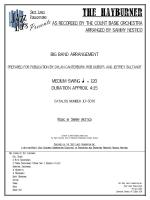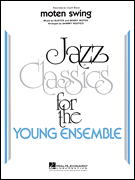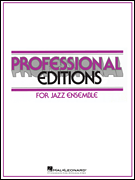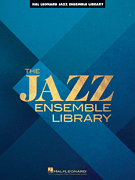HAYBURNER, THE (HAY BURNER)
As Recorded by the Count Basie Orchestra
Arranged by Sammy Nestico, Prepared for Publication by Dylan Canterbury, Rob DuBoff, and Jeffrey Sultanof

Cat #: JLP-5057
$65.00This item usually ships within 1 business day.
Questions?
Please call +1-518-587-1102 or email us.
Edition: Jazz Big Band Arrangement
Description: Swing - Difficult
Publisher: Jazz Lines Publications
Sammy Nestico's Hayburner has become one of the best-known entries in the sizable library of the Count Basie Orchestra for good reason. Largely through-composed, its easygoing melody pairs perfectly with a hard-driving sense of swing to produce unforgettable results. This publication is based on the original set of parts used by the Basie band on its 1968 recording Basie, Straight Ahead. On that note, Sammy titled this The Hayburner in the original parts and in his 1967 copyright registration; however, for the album release it was re-titled to Hay Burner.
Beginning, as is so often the case for the Basie organization, with a piano solo, the melody is first introduced by a duo of flute and muted trumpet. More instrument groups slowly add themselves to the mix leading into the bridge, where the band reaches an early peak before dropping back off for the final A section. The volume ratchets up again for a joyful mini-shout chorus at measure 43, with the band tailing off a few measures later for another short Basie piano statement.
Stepping into the spotlight at measure 59, the saxes play an intricate solo over the harmony of the bridge, which is repeated twice to give a little bit of a twist to the tune's otherwise straight-ahead structure. A slowly building interlude at measure 75 sees each section of the band re-introduce themselves before one of the most recognizable shout choruses in big band jazz takes flight at measure 84, with the band playing at full volume and jubilance. The volume backs off for another brief piano solo, with the shout leading back into the final portion of the melody. Following the melody is a rhythmically syncopated outro that sees the brass climbing up into the upper reaches of their instrument for the chart's final pronouncement.
This publication was prepared from the original parts that were used during the 1968 recording session - this is not a transcription, nor has anything been simplified or altered from the original parts.
2 Alto Saxophones
2 Tenor Saxophones (Tenor Sax. 1 Doubles Flute)
Baritone Saxophone
4 Trumpets
3 Trombones
Bass Trombone
Guitar
Piano
Bass
Drum Set
Trumpet 2: E6
Trombone 1: C5











